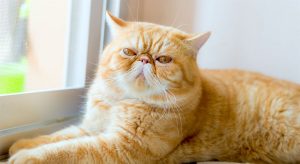Basic information about Exotic Shorthair Cats
Exotic Shorthair cats are a delightful breed known for their adorable appearance, sweet temperament, and easygoing nature. Here’s an overview of the characteristics, history, and care requirements of Exotic Shorthairs:
Appearance
Exotic Shorthairs resemble the Persian breed in appearance, with their round faces, large eyes, and flat noses, but they have short, dense coats instead of the Persian’s long fur. They come in a variety of colors and patterns, including solid colors, tabby, bicolor, and calico.
Temperament
Exotic Shorthairs are known for their gentle, affectionate, and laid-back personalities. They are typically calm and easygoing cats that enjoy lounging around and being in the company of their human companions. They are generally good with children and other pets, making them excellent family pets.
History
Exotic Shorthairs were developed in the 1950s and 1960s in the United States. Breeders aimed to create a breed that retained the Persian’s charming appearance but with a shorter, more manageable coat. To achieve this goal, breeders crossed Persians with various shorthaired breeds, including American Shorthairs, Burmese, and Russian Blues. These crosses introduced the gene for short hair while maintaining the Persian’s distinctive features, such as their round faces, large eyes, and flat noses.
As the breeding program progressed, Exotic Shorthairs began to gain recognition as a distinct breed. In 1967, the Cat Fanciers’ Association (CFA) recognized Exotic Shorthairs for championship competition. The breed was also recognized by other major cat registries, including The International Cat Association (TICA).

Care
Exotic Shorthairs have a dense, short coat that requires minimal grooming compared to the Persian breed. Regular brushing helps to remove loose hair and prevent matting, especially during shedding seasons. Additionally, routine veterinary check-ups, proper nutrition, and dental care are essential for keeping Exotic Shorthairs healthy and happy.
Health
Exotic Shorthairs are generally healthy cats, but like all breeds, they may be prone to certain health issues. These can include brachycephalic airway syndrome due to their flat faces, dental problems, and polycystic kidney disease. Responsible breeding practices and regular veterinary care can help minimize the risk of these health concerns.
Popularity
Exotic Shorthairs have become increasingly popular over the years due to their charming appearance and affectionate nature. They are recognized by major cat registries, including The International Cat Association (TICA) and the Cat Fanciers’ Association (CFA), and are commonly found in households as cherished companions.
Loyal Companions
Exotic Shorthair cats are known for forming strong bonds with their owners and are often loyal and devoted companions. Many people appreciate their affectionate nature and enjoy the companionship they provide.
Lifespan
The lifespan of Exotic Shorthair cats is typically around 12 to 15 years, though some individuals may live longer with proper care and attention to their health. Factors such as genetics, diet, environment, and access to veterinary care can influence a cat’s lifespan.
With good care, including regular veterinary check-ups, a balanced diet, exercise, and a stimulating environment, Exotic Shorthairs can lead long and healthy lives. It’s essential to monitor their health closely and address any health concerns promptly to ensure they live happy and comfortable lives.
As with any cat breed, responsible breeding practices and providing a loving and supportive home environment can contribute to the overall well-being and longevity of Exotic Shorthair cats.

Overall, Exotic Shorthair cats are wonderful pets known for their sweet temperament, charming appearance, and easy-care coats. They make excellent companions for families, singles, and seniors alike, providing love, affection, and companionship to their owners.
Posts you might also be interested in:
TRANSPORTING GOODS ALONGSIDE PETS

